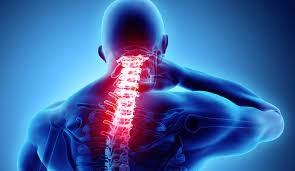Cervical Spinal Compression from an Overhead Pressing Motion
/By Ryan Rossow
The standing overhead press (OHP) is largely regarded as one of the most effective strength and hypertrophy muscle-building exercises; due to the exercise having the longest kinetic chain of any lift as well as its compound nature incorporating muscle groups from the chest, shoulders, upper back, neck, and core. Standing OHP is trained by athletes, recreational lifters, and even in the military. Athletes that take part in overhead movements such as throwing sports such as the quarterback in American football and baseball train this lift to strengthen their deltoid muscle group for greater exit velocity of the ball and greater control during their deceleration arm of a throw. Other sports like swimming train OHP to strengthen their deltoid group as well. Recreational lifters and competing weightlifters swear by OHP’s effectiveness for overall upper body muscle development. The military uses a variation of OHP called the ammo lift as a tested upper-body endurance exercise. The exercise is done with a 5.56-mm ammo can which is loaded to approximately thirty pounds; participants will then conduct an OHP with the ammo can for a maximum number of repetitions.
The exercise itself is conducted as follows. The starting position rests the bar in the hand on top of the abductor pollicis brevis. Along with this, the bar is stationary on the clavicular head of the pectoralis major. The back is maintained in sagittal alignment, with upper extremities set at biacromial breadth, or just outside, for maximum force output. When pressing, pelvis stability and knees in full extension are key to maintaining a rooted state. During the pressing motion, the anterior and lateral deltoids engage by moving the arm up and over the head. As the arms are raised the head moves slightly forward and the bar lies in a sagittal plane above the head. The scapula upward rotates approximately 60 degrees, and the movement ends with a “shrug” by engaging the rhomboids trapezius levator scapulae and elevating the shoulder girdle. This is necessary as it takes the pressure off of the rotator cuff. It is necessary to engage the core. This can be done through a bracing technique by inhaling and pushing the abdominal wall out to create a sturdy core. The lifter will then need to exhale once the rep is completed. It is also recommended to control the eccentric portion of the lift by slowly lowering the weight back down to its starting position. There is a possibility when conducting heavy standing OHP a slight lordotic back position may occur for increased stability.
While OHP may be an excellent exercise there is reason to believe there are potential downsides to the participant's long-term disc health. The shoulder joint takes the majority of the force from OHP. However, significant findings show that weakened shoulder motility or shoulder impingement can lead to cervical disc compression. Shoulder motility and impingement are commonly caused by decreased subacromial space. The subacromial bursa, rotator cuff tendons, and the long head of the bicep can become injured as they enter the subacromial space. It is interesting to note potential genetic causes of the decreased size of the subacromial space such as bony anomalies projecting into the subacromial space such as a hooked acromion or bone spur formation on the clavicle. While genetic conditions can cause shoulder impingement it is more often than not caused by overuse or intensity to the shoulder joint. As nerves in the shoulder are compressed it may cause weakness in that area. This can lead to more of the load needing to be managed by the trapezius and rhomboids when a load is above the head. This in turn leads to neck tightness and possible cervical disc compression when pushing with higher intensity or poor neck positioning.
Another possible mechanism for shoulder impingement is that of posterior capsular tightness. This is common in throwing athletes as it stems from the deceleration of the arm after the release of the object. The same muscles involved in the deceleration portion of a throw are also involved in the lockout and eccentric portions of the OHP. The trapezius, rhomboids, and serratus anterior are involved in stabilizing the shoulder girdle and the scapula. When performing the lockout of OHP the trapezius and rhomboids are engaged to lift the shoulder and take pressure off of the rotator cuff. With a weakened rotator cuff, too heavy of a load, or a poor neck position cervical disc compression and neck pain can be experienced.
It is nearly impossible to measure disc compression with imaging, however, the different mechanisms mentioned above are potential indicators that disc compression could occur. When testing the OHP variables such as load and form must be taken into account. Previous studies have conducted measured shoulder impingement and neck injury primarily having the participant carry out a movement and loading the movement using percentages based upon their one-rep max (1RM). A field test was conducted using five participants with an average age of twenty, an average weight of 179 lbs, and an average height of 72 inches. Participants were measured by carrying out a standing OHP with 25%, 50%, and 75% of their 1RM. During these lifts, participants conducted the lift for three different repetitions: first their neck in a flexed state, then in a neutral state, and finally in an extended state. Participants were then asked to describe any tightness, pain, or discomfort when performing the lifts.
The results from this match previous data that has been collected. When participants conducted the OHP with 25% and 50% of their 1RM, none felt discomfort or tightness in the cervical spine, splenius capitis, or trapezius in any of the neck positions. However, when conducting the OHP with 75% of their 1RM there were varying degrees of discomfort. The most common complaint was trapezius tightness, and some shoulder discomfort, which occurred at the end of the lift when the neck was in a neutral position. When the neck was in the extended position with this load, there was a lack of tightness or pain but participants tended to compensate for the lift by leaning back and utilizing their lumbar and thoracic spine to support the weight. No pain or tightness in the lower back, yet noted nonetheless. The most interesting finding occurred during neck flexion. Participants described an array of complaints from cervical neck pain, trapezius tightness, splenius capitis tightness, and signs of shoulder impingement.
The study conducted was largely anecdotal and had a small sample size, however yielded data that needs to be analyzed further. The possibility of cervical disc compression with the overhead pressing movement is possible, yet not proven. From the research conducted, it can be perceived that if the OHP can lead to cervical disc compression it would be due to poor neck position, or too overbearing of a load. Due to the mechanism of the OHP, the data collected is plausible with biomechanics. The neck being in a flexed position would cause excess strain on the splenius capitis or trapezius which could lead to cervical disc compression. Outside of the
neck position, shoulder pain or discomfort occurred in participants when lifting 75% of their 1RM in all neck positions. This discomfort and pain are possible signs of shoulder impingement, a previously described potential cause of cervical disc compression. While there is no clear evidence without magnetic resonance imaging (MRI), solutions and potential plans can be derived. It is recommended when conducting the standing OHP to ensure optimal neck position which occurs in the neutral position. By allowing the neck to be in an equal plane with the spine there is a decreased chance for splenius capitis or trapezius discomfort. Along with this, the OHP should be performed with a load that can be cautiously controlled to decrease the chance of shoulder impingement.
References
Amar, M. R., Cochran, D., & Woldstad, J. (2017, March 6). The effect of single-handed lifting tasks on the activation of the neck-shoulder shared musculature. International Biomechanics. Retrieved June 14, 2022, from https://www.ncbi.nlm.nih.gov/pmc/articles/PMC7857450/
Body anatomy: Upper extremity muscles: The hand society. Body Anatomy: Upper Extremity Muscles | The Hand Society. (n.d.). Retrieved June 14, 2022, from https://www.assh.org/handcareprod/safety/muscles
Figure 43: Biacromial breadth measurement - researchgate. (n.d.). Retrieved June 15, 2022, from https://researchgate.net/figure/Biacromial-Breadth-measurement_fig26_273134617
How serious is your spine compression during OHP? - strengthisfirst. (n.d.). Retrieved June 15, 2022, from https://strengthisfirst.com/training/overhead-press-spine-compression
The Overhead Press: Mastering the basics: Rehab-U blog. Rehab. (2021, February 15). Retrieved June 14, 2022, from https://rehab-u.com/the-overhead-press-mastering-the-basics/
Pheasant, S. (2016, December). Cervical contribution to functional shoulder impingement: Two case reports. International journal of sports physical therapy. Retrieved June 14, 2022, from https://www.ncbi.nlm.nih.gov/pmc/articles/PMC5095950/
Rosa, D. P., Borstad, J. D., Ferreira, J. K., & Camargo, P. R. (2019, March 28). Influence of glenohumeral joint posterior capsule tightness and impingement symptoms on shoulder impairments and Kinematics. OUP Academic. Retrieved June 14, 2022, from https://academic.oup.com/ptj/article-abstract/99/7/870/5421642?redirectedFrom=fulltext# no-access-message
Scientific Electronic Library Online. SciELO. (n.d.). Retrieved June 14, 2022, from http://www.scielo.org.za/
Seroyer, S. T., Nho, S. J., Bach, B. R., Bush-Joseph, C. A., Nicholson, G. P., & Romeo, A. A. (2010, March). The kinetic chain in overhand pitching: Its potential role for performance enhancement and injury prevention. Sports health. Retrieved June 14, 2022, from https://www.ncbi.nlm.nih.gov/pmc/articles/PMC3445080/#:~:text=During%20deceleratio n%2C%20there%20is%20marked,extending%20elbow%20and%20pronating%20forear m.&text=The%20trapezius%2C%20rhomboids%2C%20and%20serratus,the%20stabiliza tion%20of%20the%20scapula.
Splenius capitis muscle. GetBodySmart. (2020, April 23). Retrieved June 14, 2022, from https://www.getbodysmart.com/neck-muscles/splenius-capitis-muscle
Stew Smith, C. S. C. S. (2021, September 24). Marine Corps Combat Fitness Test (CFT). Military.com. Retrieved June 14, 2022, from https://www.military.com/military-fitness/marine-corps-fitness-requirements/marine-corp s-combat-fitness-test
Watson, H., Simpson, A., & Riches, P. E. (2012, December). The effects of upper limb loading on spinal shrinkage during treadmill walking. European spine journal : official publication of the European Spine Society, the European Spinal Deformity Society, and the European Section of the Cervical Spine Research Society. Retrieved June 14, 2022, from https://www.ncbi.nlm.nih.gov/pmc/articles/PMC3508204/
Zeutschel, D. E. (2022, June 1). Why everyone should press overhead. Progressive Rehab & Strength. Retrieved June 14, 2022, from https://www.progressiverehabandstrength.com/articles/press




